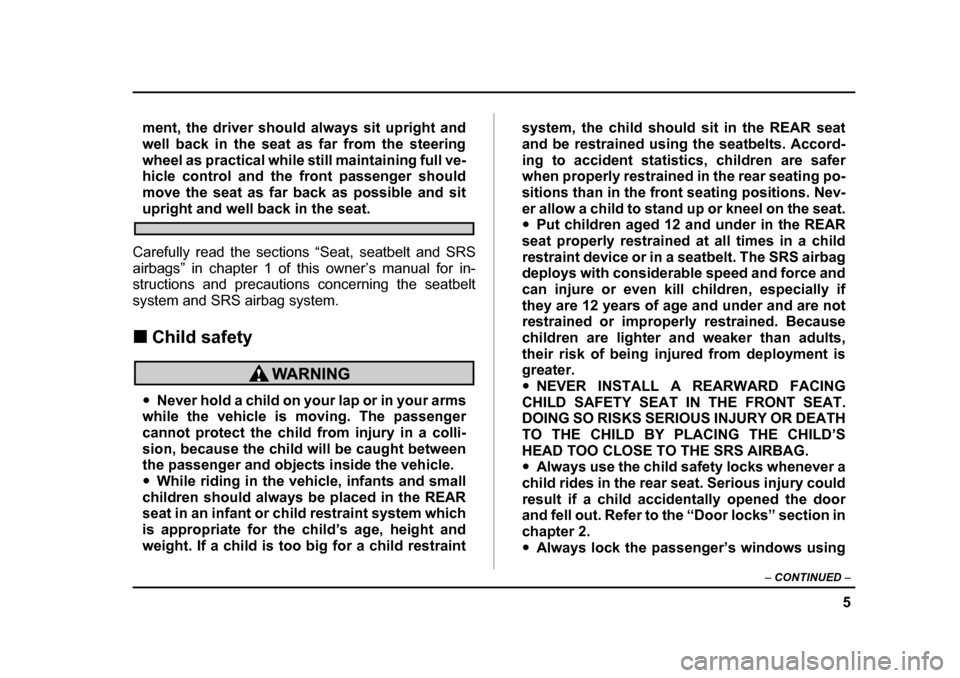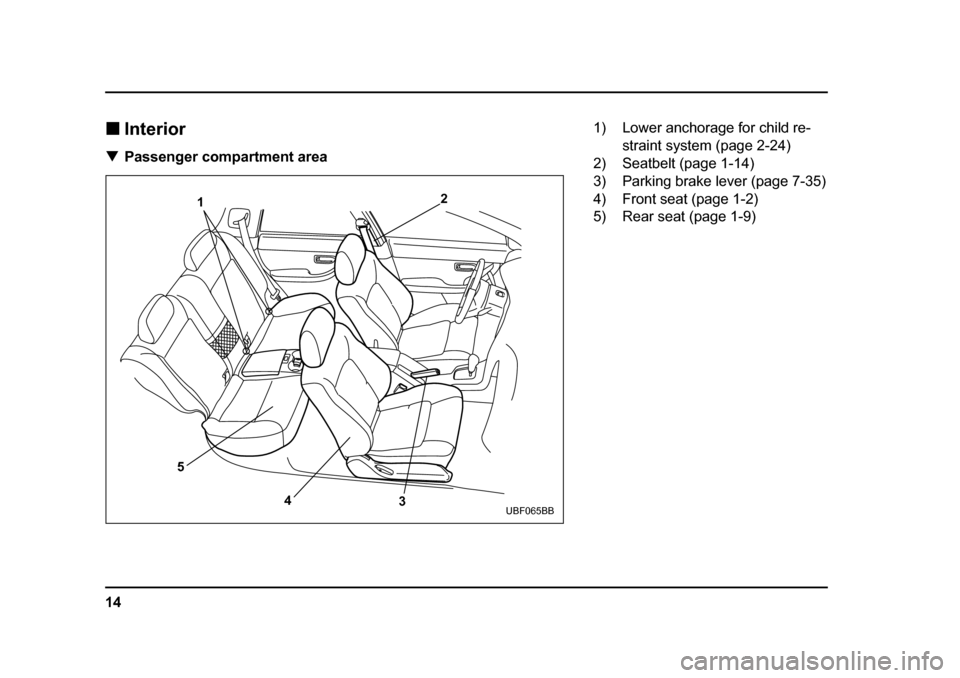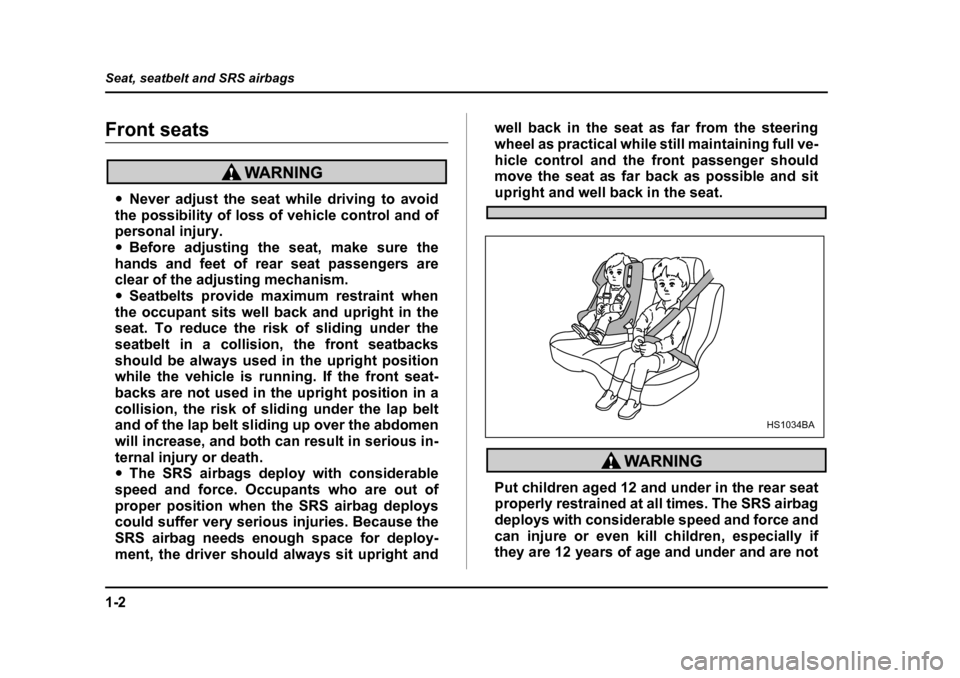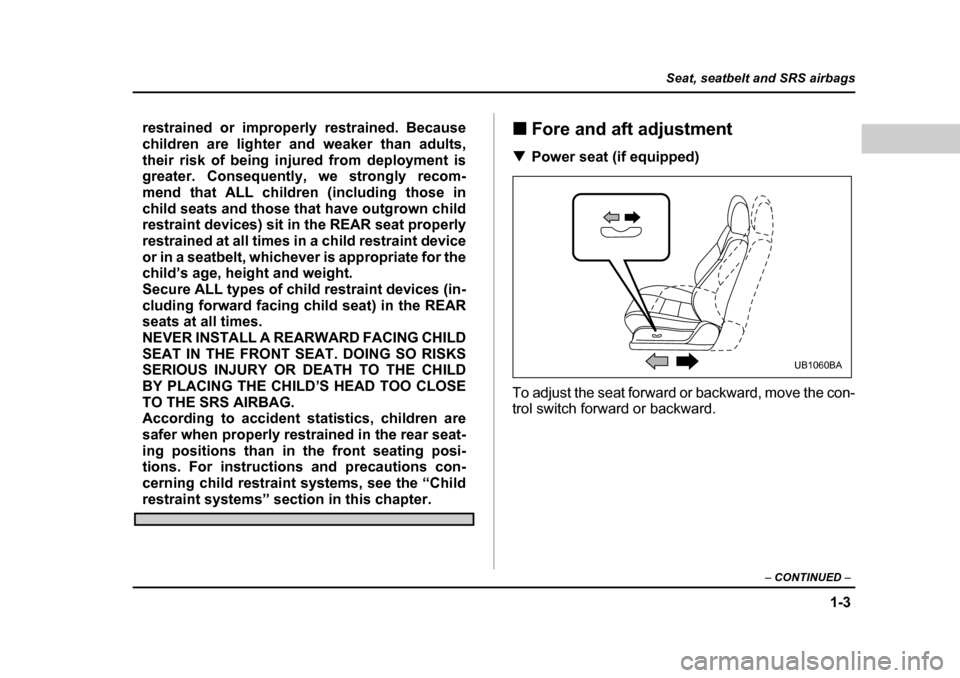2006 SUBARU BAJA child seat
[x] Cancel search: child seatPage 8 of 487

5
–
CONTINUED –
ment, the driver should always sit upright and
well back in the seat as far from the steering
wheel as practical while still maintaining full ve-
hicle control and the front passenger should
move the seat as far back as possible and sit
upright and well back in the seat.
Carefully read the sections “Seat, seatbelt and SRS
airbags” in chapter 1 of this owner’s manual for in-
structions and precautions concerning the seatbelt
system and SRS airbag system. �„ Child safety
�yNever hold a child on your lap or in your arms
while the vehicle is moving. The passenger
cannot protect the child from injury in a colli-
sion, because the child will be caught between
the passenger and objects inside the vehicle. �y While riding in the vehicle, infants and small
children should always be placed in the REAR
seat in an infant or child restraint system which
is appropriate for the child’s age, height and
weight. If a child is too big for a child restraint system, the child should sit in the REAR seat
and be restrained using the seatbelts. Accord-
ing to accident statistics, children are safer
when properly restrained in the rear seating po- sitions than in
the front seating positions. Nev-
er allow a child to stand up or kneel on the seat. �y Put children aged 12 and under in the REAR
seat properly restrained at all times in a child
restraint device or in a seatbelt. The SRS airbag
deploys with considerable speed and force and
can injure or even kill children, especially if
they are 12 years of age and under and are not
restrained or improperly restrained. Because
children are lighter and weaker than adults,
their risk of being injured from deployment is
greater. �y NEVER INSTALL A REARWARD FACING
CHILD SAFETY SEAT IN THE FRONT SEAT.
DOING SO RISKS SERIOUS INJURY OR DEATH
TO THE CHILD BY PLACING THE CHILD’S
HEAD TOO CLOSE TO THE SRS AIRBAG. �y Always use the child safety locks whenever a
child rides in the rear seat. Serious injury could
result if a child accidentally opened the door
and fell out. Refer to the “Door locks” section in
chapter 2.�y Always lock the passenger’s windows using
Page 9 of 487

6
the lock switch when children are riding in the
vehicle. Failure to follow this procedure could
result in injury to a child operating the power
window. Refer to the “Power windows” section
in chapter 2.�y Never leave unattended children in the vehi-
cle. They could accidentally injure themselves
or others through inadvertent operation of the
vehicle. Also, on hot or sunny days, tempera-
ture in a closed vehicle could quickly become
high enough to cause severe or possibly fatal
injuries to them.
Carefully read the sections “Child restraint sys-
tems”,“*SRS airbag (Supplemental Restraint System
airbag)”, and “Seatbelts” in chapter 1 of this owner’s
manual for instructions and precautions concerning
the child restraint system, seatbelt system and SRS
airbag system. �„ Engine exhaust gas (carbon monox- ide)
�yNever inhale engine exhaust gas. Engine ex- haust gas contains carbon monoxide, a color-
less and odorless gas
which is dangerous, or
even lethal, if inhaled. �y Always properly maintain the engine exhaust
system to prevent engine exhaust gas from en-
tering the vehicle. �y Never run the engine in a closed space, such
as a garage, except for th e brief time needed to
drive the vehicle in or out of it.�y Avoid remaining in a parked vehicle for a
lengthy time while the engine is running. If that
is unavoidable, then use the ventilation fan to
force fresh air in to the vehicle.
�y Always keep the front ventilator inlet grille
free from snow, leaves or other obstructions to
ensure that the ventilation system always
works properly.�y If at any time you suspect that exhaust fumes
are entering the vehicle, have the problem
checked and corrected as soon as possible. If
you must drive under these conditions, drive
only with all windows fully open.
Page 17 of 487

14
�„
Interior
�T Passenger compartment area
1 2
5 4 3
UBF065BB
1) Lower anchorage for child re-
straint system (page 2-24)
2) Seatbelt (page 1-14)
3) Parking brake lever (page 7-35)
4) Front seat (page 1-2)
5) Rear seat (page 1-9)
Page 26 of 487

1-1
1
Seat, seatbelt and SRS airbags
Front seats .................................................... 1-2 Fore and aft adjustment ................................... 1-3
Seat cushion angle and height adjustment (Power seat only) ........................................... 1-4
Reclining the seatback ..................................... 1-5
Head restraint adjustment ................................ 1-6
Lumbar support (if equipped) .......................... 1-7
Seat heater (if equipped) .............................. 1-7
Rear seats ..................................................... 1-9 Rear headrest .................................................... 1-9
Folding down the rear seat .............................. 1-10
Seatbelts ....................................................... 1-14 Seatbelt safety tips ........................................... 1-14
Emergency Locking Retractor (ELR) .............. 1-16
Automatic/Emergency Locking Retractor (A/ELR) ............................................................ 1-16
Seatbelt warning light and chime ............... 1-17
Fastening the seatbelt ...................................... 1-17
Seatbelt maintenance ....................................... 1-21
Seatbelt extender ......................................... 1-22
Front seatbelt pretensioners ....................... 1-24 System monitors ............................................... 1-25
System servicing .............................................. 1-26
Precautions against vehicle modification ...... 1-27
Child restraint systems ..... ........................... 1-28
Where to place a child restraint system ......... 1-29
Choosing a child restraint system .................. 1-31
Installing child restraint systems with A/ELR seatbelt ............................................................ 1-32 Installation of child restraint systems by use
of lower and tether anchorages (LATCH) .... 1-40
Installing a booster seat ................................... 1-45
*SRS airbag (Supplemental Restraint System airbag) ........................................... 1-47Vehicle with driver’s and front passenger’s SRS airbags and lap/shoulder restraints ..... 1-47
SRS frontal airbag ............................................ 1-52
SRS airbag system monitors ........................... 1-60
SRS airbag system servicing .......................... 1-61
Precautions against vehicle modification ...... 1-62
Page 27 of 487

1-2
Seat, seatbelt and SRS airbags
Seat, seatbelt and SRS airbagsFront seats
�y
Never adjust the seat while driving to avoid
the possibility of loss of vehicle control and of
personal injury. �y Before adjusting the seat, make sure the
hands and feet of rear seat passengers are
clear of the adjusting mechanism. �y Seatbelts provide maximum restraint when
the occupant sits well back and upright in the
seat. To reduce the risk of sliding under the
seatbelt in a collision, the front seatbacks
should be always used in the upright position
while the vehicle is running. If the front seat-
backs are not used in the upright position in a
collision, the risk of sliding under the lap belt
and of the lap belt sliding up over the abdomen
will increase, and both can result in serious in-
ternal injury or death.�y The SRS airbags deploy with considerable
speed and force. Occupants who are out of
proper position when the SRS airbag deploys
could suffer very serious injuries. Because the
SRS airbag needs enough space for deploy-
ment, the driver should always sit upright and well back in the seat as far from the steering
wheel as practical while still maintaining full ve-
hicle control and the front passenger should
move the seat as far back as possible and situpright and well back in the seat.
Put children aged 12 and under in the rear seat
properly restrained at all times. The SRS airbag
deploys with considerable speed and force and
can injure or even kill children, especially if
they are 12 years of age and under and are not
HS1034BA
Page 28 of 487

1-3
Seat, seatbelt and SRS airbags
– CONTINUED –
restrained or improperly restrained. Because
children are lighter and weaker than adults,
their risk of being injured from deployment is
greater. Consequently, we strongly recom-
mend that ALL children (including those in
child seats and those that have outgrown child
restraint devices) sit in the REAR seat properly
restrained at all times in a child restraint device
or in a seatbelt, whichever is appropriate for the
child’s age, height and weight.
Secure ALL types of child restraint devices (in-
cluding forward facing child seat) in the REAR
seats at all times.
NEVER INSTALL A RE ARWARD FACING CHILD
SEAT IN THE FRONT SEAT. DOING SO RISKS
SERIOUS INJURY OR DEATH TO THE CHILD
BY PLACING THE CHILD ’S HEAD TOO CLOSE
TO THE SRS AIRBAG.
According to accident statistics, children are
safer when properly restrained in the rear seat-
ing positions than in the front seating posi-
tions. For instructions and precautions con-
cerning child restraint systems, see the “Child
restraint systems” section in this chapter. �„
Fore and aft adjustment
�T Power seat (if equipped)
To adjust the seat forward or backward, move the con-
trol switch forward or backward.
UB1060BA
Page 39 of 487

1-14
Seat, seatbelt and SRS airbags
place and make sure that they are securely locked.
Make sure that the rear seatbelt buckles are not under
the seat cushion or seatback, when returning the seat
cushion and the seatback to their original position.
Confirm that the rear seatbelts are stored in the
seatbelt pocket prior to returning the seat cush-
ion to its original position.
Seatbelts �„
Seatbelt safety tips
�yAll persons in the vehicle should fasten their
seatbelts BEFORE the vehicle starts to move.
Otherwise, the possibility of serious injury be-
comes greater in the event of a sudden stop or
accident.�y All belts should fit snugly in order to provide
full restraint. Loose fitting belts are not as ef-
fective in preventing or reducing injury.�y Each seatbelt is designed to support only
one person. Never use a single belt for two or
more persons – even children. Otherwise, in an
accident, serious injury or death could result. �y Replace all seatbelt assemblies including re-
tractors and attaching hardware worn by occu-
pants of a vehicle that has been in a serious ac-
cident. The entire assembly should be replaced
even if damage is not obvious.�y Put children aged 12 and under in the rear
seat properly restrained at all times. The SRS
airbag deploys with considerable speed and
force and can injure or even kill children, espe-
Page 40 of 487

1-15
Seat, seatbelt and SRS airbags
– CONTINUED –
cially if they are 12 years of age and under and
are not restrained or improperly restrained. Be-
cause children are lighter and weaker than
adults, their risk of being injured from deploy-
ment is greater. Consequently, we strongly rec-
ommend that ALL children (including those in
child seats and those that have outgrown child
restraint devices) sit in the REAR seat properly
restrained at all times in a child restraint device
or in a seatbelt, whichever is appropriate for the
child’s height and weight.
Secure ALL types of child restraint devices (in-
cluding forward facing child seats) in the REAR
seats at all times.
NEVER INSTALL A RE ARWARD FACING CHILD
SEAT IN THE FRONT SEAT. DOING SO RISKS
SERIOUS INJURY OR DEATH TO THE CHILD
BY PLACING THE CHILD ’S HEAD TOO CLOSE
TO THE SRS AIRBAG.
According to accident statistics, children are
safer when properly restrained in the rear seat-
ing positions than in the front seating posi-
tions. For instructions and precautions con-
cerning the child restraint system, see the
“Child restraint systems” section in this chap-
ter. �T
Infants or small children
Use a child restraint system that is suitable for your ve-
hicle. See information on “Child restraint systems”
section in this chapter. �T Children
If a child is too big for a ch ild restraint system, the child
should sit in the rear seat and be restrained using the
seatbelts. According to acci dent statistics, children are
safer when properly restrained in the rear seating po-
sitions than in the front seating positions. Never allow
a child to stand up or kneel on the seat.
If the shoulder portion of the belt crosses the face or
neck, adjust the shoulder belt anchor height (window-
side seating positions only) and then if necessary
move the child closer to the belt buckle to help provide
a good shoulder belt fit. Care must be taken to secure-
ly place the lap belt as low as possible on the hips and
not on the child’s waist. If the shoulder portion of the
belt cannot be properly positioned, a child restraint
system should be used. Never place the shoulder belt
under the child’s arm or behind the child’s back.